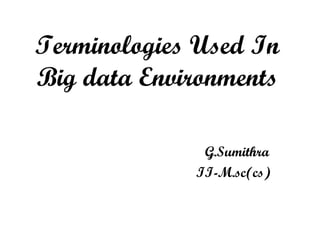G.Sumithra,II-M.sc(computer science),Bon secours college for women,thanjavur.
•
0 likes•77 views
Terminologies and its types In-Memory Analytics In-Database processing Symmetric Multiprocessor system(SMP) Massively Parallel Processing Difference Between Parallel and Distributed Systems Shared Nothing Architecture Advantages of a “ shared nothing Architecture” CAP Theorem Explained CAP Theorem
Report
Share
Report
Share
Download to read offline

Recommended
Recommended
More Related Content
What's hot
What's hot (20)
Similar to G.Sumithra,II-M.sc(computer science),Bon secours college for women,thanjavur.
Similar to G.Sumithra,II-M.sc(computer science),Bon secours college for women,thanjavur. (20)
Distributed Shared Memory notes in distributed systems.pptx

Distributed Shared Memory notes in distributed systems.pptx
Recently uploaded
Mehran University Newsletter is a Quarterly Publication from Public Relations OfficeMehran University Newsletter Vol-X, Issue-I, 2024

Mehran University Newsletter Vol-X, Issue-I, 2024Mehran University of Engineering & Technology, Jamshoro
Recently uploaded (20)
Jual Obat Aborsi Hongkong ( Asli No.1 ) 085657271886 Obat Penggugur Kandungan...

Jual Obat Aborsi Hongkong ( Asli No.1 ) 085657271886 Obat Penggugur Kandungan...
Sensory_Experience_and_Emotional_Resonance_in_Gabriel_Okaras_The_Piano_and_Th...

Sensory_Experience_and_Emotional_Resonance_in_Gabriel_Okaras_The_Piano_and_Th...
On National Teacher Day, meet the 2024-25 Kenan Fellows

On National Teacher Day, meet the 2024-25 Kenan Fellows
Python Notes for mca i year students osmania university.docx

Python Notes for mca i year students osmania university.docx
Basic Civil Engineering first year Notes- Chapter 4 Building.pptx

Basic Civil Engineering first year Notes- Chapter 4 Building.pptx
Plant propagation: Sexual and Asexual propapagation.pptx

Plant propagation: Sexual and Asexual propapagation.pptx
Exploring_the_Narrative_Style_of_Amitav_Ghoshs_Gun_Island.pptx

Exploring_the_Narrative_Style_of_Amitav_Ghoshs_Gun_Island.pptx
This PowerPoint helps students to consider the concept of infinity.

This PowerPoint helps students to consider the concept of infinity.
Beyond_Borders_Understanding_Anime_and_Manga_Fandom_A_Comprehensive_Audience_...

Beyond_Borders_Understanding_Anime_and_Manga_Fandom_A_Comprehensive_Audience_...
Unit 3 Emotional Intelligence and Spiritual Intelligence.pdf

Unit 3 Emotional Intelligence and Spiritual Intelligence.pdf
General Principles of Intellectual Property: Concepts of Intellectual Proper...

General Principles of Intellectual Property: Concepts of Intellectual Proper...
G.Sumithra,II-M.sc(computer science),Bon secours college for women,thanjavur.
- 1. Terminologies Used In Big data Environments G.Sumithra II-M.sc(cs)
- 2. contents • Terminologies and its types • In-Memory Analytics • In-Database processing • Symmetric Multiprocessor system(SMP) • Massively Parallel Processing • Difference Between Parallel and Distributed Systems • Shared Nothing Architecture • Advantages of a “ shared nothing Architecture” • CAP Theorem Explained • CAP Theorem
- 3. Terminologies and its types • In order to good handle on the big data environment. • A few key terminologies in this arena • The different types of terminologies are: In-Memory Analytics In-Database processing Symmetric Multiprocessor system(SMP) Massively Parallel Processing Difference Between Parallel and Distributed Systems Shared Nothing Architecture CAP Theorem Explained
- 4. In-Memory Analytics • Data access from non-volatile storage such as hard disk is a slow process • The data is required to be fetched from hard disk or secondary storage • One way combat this challenge is to pre-processor and store data Example: cubes, aggregate tables, query sets, etc… • The initial process of pre-computing and storing data or fetching it from secondary storage • The problem has been addressed using in-memory analytics • All the relevant data is stored in Random Access Memory(RAM)or primary storage
- 5. Advantages • Faster access • Rapid deployment • Better insights • Minimal IT involvements
- 6. In-Database processing • In-database processing is also called as in-database analytics • The data from various enterprise Online Transaction processing(OLAP) system after cleaning up example: de-duplication, scrubbing, etc… • The huge datasets are then exported to analytical programs for complex and extensive computations. • Leading database vendors are offering this feature to large business
- 7. Symmetric Multiprocessor system(SMP) • SMP is a single common main memory that is shared by two or more identical processors • To all I/O devices and are controlled by a single operating system instance • SMP are tightly coupled multiprocessor systems • Its own high-speed memory, called cache memory and are connected using a system bus
- 8. Massively Parallel Processing • Massively Parallel Processing(MPP) refers to the coordinated processing of the programs by a number of processors working parallel • Each have their own operating system and dedicated memory • They works on different parts of the same program • SMP works with the processors sharing the same operating system and same memory • SMP is also referred to as tightly-coupled multiprocessing
- 9. Difference Between Parallel and Distributed Systems Parallel system Distributed system Memory Tightly coupled system shared memory Weakly coupled system Distributed memory Control Global clock control No global clock control Processor Interconnection Order of Tbps Order of Gbps Main focus Performance Scientific Computing Performance(cost and scalability) Reliability/ availability information/resource sharing
- 11. Parallel System
- 13. Shared Nothing Architecture • The three most common type of architecture for multiprocessor high transaction rate system • They are: Shared Memory(SM) Shared Disk(SD) Shared Nothing(SN)
- 14. Shared Memory(SM) • A common central memory is shared by multiple processors Shared Disk(SD) • Multiple processors share a common collection of disks while having their own private memory Shared Nothing(SN) • If neither memory nor disk is shared among multiple processors
- 16. Advantages of a “ shared nothing Architecture” • Fault Isolation: Its provides the benefit of isolating fault A fault in a single node is contained and confined That node exclusive and exposed only through message • Scalability: The disk is a shared resource The controlled and the disk bandwidth are also shared state A different nodes will have to take turns to access the critical data A distributed shared disk system thus compromising on scalability
- 17. CAP Theorem Explained • The CAP theorem is also called the Brewer’s theorem • A collection of interconnection nodes that share data • The three types of CAP theorem they are: Consistency Availability Partition tolerance
- 18. CAP Theorem • Consistency A implies that every read fetches the last write • Availability A implies that reads and writes always succeed Each non-failing node will return a response in a reasonable amount of time • Partition tolerance It implies that the system will continue to function when network partition occurs
- 20. THANK YOU